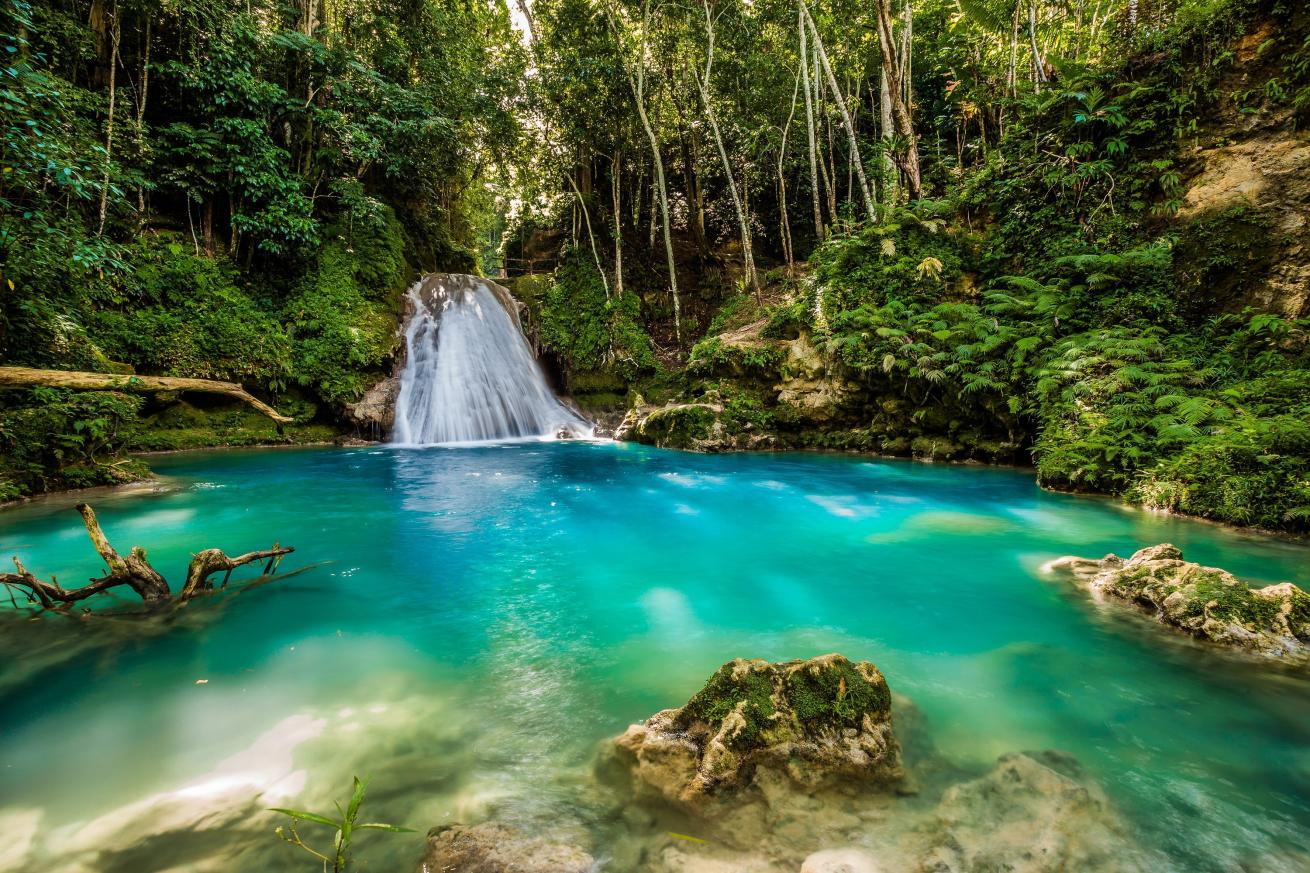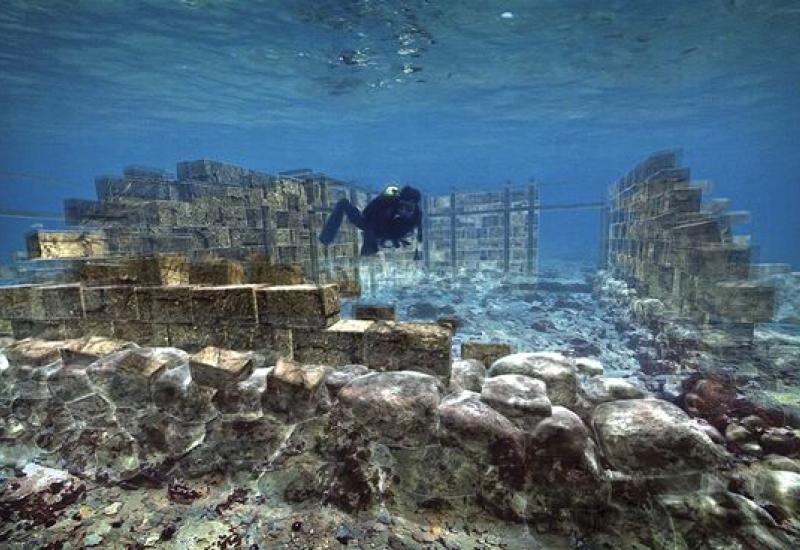Jumping Into Jamaica: A Scuba Diver’s Guide to Paradise

Shutterstock.com/Photo SpiritBlue hole, Jamaica.
From wrecks to reefs, animals to adventures, scuba diving in Jamaica has a little of everything. With more than 100 active dive sites, there’s plenty to explore. And when you’re not underwater, turn up the reggae, sprinkle on some jerk spice and relax on world-famous beaches (while enjoying the many other things Jamaica is best known for). Jamaica is a complete tropical experience that keeps many coming back for more.
Jamaica: Full of Joy
“Instead of ‘enjoying,’ we’re full-joying the moment here in Jamaica,” said PADI Instructor Marlon Gardener, who teaches at the newly reintroduced Sandals Dunn’s River Resort in Ocho Rios (a.k.a. “Ochi”), where I began my trip. “We never end the joy here while we’re diving and living life.”
Gardener means it. Thanks to him and the stellar Sandals dive teams in Montego Bay (“MoBay”) and Negril, I experienced the full joy of diving in Jamaica. After a week and a half of relaxed diving and exploring, here’s what you need to know.

Vinh Pham PhotographyThe dive group at Ocho Rios celebrates after a day of stellar diving.
Protections in Place
Jamaica is best known for its resorts, beaches, food and music. Despite 478 square miles of coral reefs, Jamaica’s scuba diving has historically been overlooked by international travelers due to past hurricane damage and destructive fishing practices.

Tiffany Duong/Ocean RebelsMild currents in Negril allow for relaxed and slow diving–and seahorse spotting, says dive guide Robin “Robin Hood” Dixon.
In the 1990s, the nation began protecting its ocean resources. Today, there are five marine protected areas (MPAs). These protections, which have been in place for 20 to 30 years, are helping to bring back the coral reefs.
Jamaica is now considered an up-and-coming dive destination. Before the international dive community fully catches on, those who dive here can “full joy” Jamaica’s underwater beauty with fewer crowds.
What You Can See While Diving
The top-rated areas for diving in Jamaica are Ochi, MoBay and Negril, which are all designated MPAs. Each boasts interesting natural and artificial reefs, with signs of marine life recovery. While bigger marine life is slowly returning, there is still plenty to see and enjoy–starting with some incredible plane wrecks.
Related Reading: Five Great Shipwrecks to Explore in Grenada
Plane Wrecks

Tiffany Duong/Ocean RebelsThe “Plane Wreck” in Montego Bay blew my mind! It was the first time I’d ever seen an airplane underwater.
With 400 dives in my logbook, I had yet to dive a plane wreck before; in one week in Jamaica, I explored and penetrated three! One of my favorite dives to date, MoBay’s “Plane Wreck”—is alluring. As we descended to 75 feet, the familiar outline of wings and a body became clear on the seafloor. It was wild to “drop down” on the wreck head-on, getting a unique view from above, then swimming through the fuselage. In my dive log, I wrote about how this juxtaposition of sky-high and bottom-of-sea “blew my mind” and how I “won’t forget it.”

Tiffany Duong/Ocean RebelsThe author Tiffany Duong peaks through the “window seat” of a sunken DC-3 airplane in Montego Bay.
In Negril, PADI Master Scuba Diver Trainer Sanjay “Cialis” Spencer took me through two small Cessna wrecks on the same day. The first, called “Plane Deep,” crashed during a drug-smuggling run. By the time the authorities arrived to investigate, the illicit cargo had already been offloaded, and the authorities decided to let the wreckage sink. Today, the wreck is filled with marine life, and you can still find the propeller blade lodged in a nearby reef.
Captivating Caverns
Aside from wrecks galore, there are also stunning natural caverns in which the sunbeams shine and dance through swirling natural rock formations. “The Arches,” in Negril, is one such site; the dolphins that accompanied us as we explored have me dreaming of returning soon.
In Ochi, we got the best of both worlds diving on the SS Kathryn and its nearby caverns. As advanced divers, we were able to enter the wreck and penetrate the wheelhouse, to a max depth of nearly 50 feet. We started our ascent as Gardener led us through intricate and complex cavern systems at shallower depths. Inside, divers can see nurse sharks, southern stingrays, lobsters, eels, sea snakes and tons of fish.

Tiffany Duong/Ocean RebelsThe caverns surrounding Catherine’s Wreck in Ocho Rios were stunning as the afternoon sun danced through cracks in the structures.
Comfort and Convenience
Throughout the year, Jamaica enjoys calm conditions, warm water and clear visibility. It’s pleasant diving for all, and particularly appealing for beginner and intermediate divers.
“Diving in Jamaica is relaxing,” said Robin “Robin Hood” Dixon, a PADI Instructor at Sandals Negril. “The current normally is mild, so you have a chance to slow down and take a look at small stuff like seahorses.”
Late summer is the best season because of the bathtub-warm water and lack of winds, said Durvan “Stewy” Stewart, a PADI Instructor at Sandals MoBay. Laughing, he added that winter water temperatures are a “bearable” 78 to 82°F.
Related Reading: Ask DAN: How Can I Stay Warmer Underwater?
Additionally, all our dive sites were a five- to 15-minute boat ride from shore. Max. Talk about convenience. This is helpful for those who get seasick or affected by fumes, said Cialis. “It only takes five to seven minutes to get to any sites in Negril,” he said. “Then, the corals are like mountains—out of this world! The water is flat and calm, and there’s plenty to see.”

Tiffany Duong/Ocean RebelsTo divers’ delight, a pod of wild dolphins followed them around The Arches dive site in Negril.
“You don’t have to go far to get to deep water in Jamaica,” said Sandals MoBay Watersports Manager Anthony England. In particular, England referenced the Cayman Trench near MoBay and Ochi, which allows excellent wall dives and pelagic encounters within a short ride from shore. One of these, Widowmaker’s Cave, is consistently rated among Jamaica’s Top Dive Sites.
Need to Know
When to Visit: Jamaica is diveable year round, with the high season and warmer waters from June to September.
Conditions: Water temperatures range between 78°F and 92°F year round, with an average of 82°F. Surface conditions are usually calm. Visibility bottoms out at 60 feet but can reach hundreds of feet. Storms reduce visibility, but currents typically clear sediment quickly.
Equipment: I wore a skinsuit and hood for comfort in August. Divers may want to wear a 1 mm to 3 mm wetsuit if they get cold and/or they’re diving in the winter.
Getting to Jamaica: Sangster International Airport (MBJ) in Montego Bay is a great, central landing point to explore Ochi, Negril and MoBay. February is the cheapest month to fly to MBJ, and there are daily direct flights from many major U.S. and European cities.
Entry Requirements: Passport; visa-free travel is available for shorter stays for citizens of the U.S., Canada, Australia, Britain and certain European countries.
Getting Around: Local shuttles or taxis can easily get you from one area to the next, with most drives between different cities in Jamaica lasting one hour to a few hours long. Travelers can also rent a car at any airport.
Topside Tips: Jamaica has equally beautiful topside adventures for your surface interval. Take a bamboo raft down the Martha Brae River, explore the waterfalls at Dunn’s River or enjoy a night swim in the Luminous Lagoon—the world’s brightest bioluminescent bay.
To Try: Foodies, don’t miss jerk pork or chicken from a roadside jerk shack, oxtail at Father Bull and Jamaican patties from Juici. Enjoy local Blue Mountain coffee, Red Stripe beer and Appleton rum. For an extra-special treat, try a gourmet, garden-to-table Rasta meal in the backcountry at Stush in the Bush.







